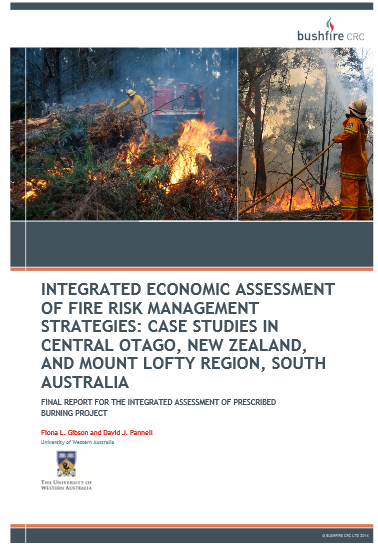
PUBLICATIONS
Published works

Integrated economic assessment of fire risk management strategies: Case studies in Central Otago, New Zealand, and Mount Lofty Region, South Australia
| Title | Integrated economic assessment of fire risk management strategies: Case studies in Central Otago, New Zealand, and Mount Lofty Region, South Australia |
| Publication Type | Report |
| Year of Publication | 2014 |
| Authors | Pannell, DJ, Gibson, FL |
| Date Published | 24/02/2014 |
| Institution | Bushfire CRC |
| City | Melbourne, Australia |
| ISBN Number | 978 - 0 - 9875218 - 6 - 6 |
| Keywords | fire management, risk management |
| Abstract | There are various options available to fire managers for strategically reducing losses from future fires. With limited funds, an increasing population to protect from fire, and an increasing tendency for people to live in fire-prone areas, fire managers face a significant resource allocation challenge. Knowing which fire-risk mitigation strategies provide the best value for money is potentially of great benefit. However the assessment of fire prevention strategies is complex, requiring integration of a large volume of information of various different types (technical, social, economic). The aim of this study is to provide insights into the question of which fire-prevention strategies provide the best value for money? The approach taken in this analysis was inspired by INFFER (the Investment Framework for Environmental Resources), particularly by its application to the Gippsland Lakes. The management problem addressed in that study was similarly complex as the fire management problem. It was addressed using a quantitative analysis that integrated information about risk, management, costs, and values, in a spatial context, with high levels of stakeholder consultation. A broadly similar approach is applied in this study. We present a quantitative decision framework to provide an integrated assessment of the benefits and costs of fire risk management strategies. Key findings from the project follow below. It is important to remember that these are specific pilot studies (and hence the outcomes relate to the two study areas and the scope of the analyses conducted). Generalisations about prescribed burning for other areas and circumstances should not be drawn from these studies. This project shows that the methodology works and can provide valuable decision-making inputs to fire management programs. Various fire risk management strategies have potential to generate benefits, but they should be applied in a targeted way. This was particularly the case for prescribed burning in the Mount Lofty region study (South Australia), where a general prescribed burning strategy across all sub-regions does not provide value for money but prescribed burning in targeted sub-regions does. Some strategies have particularly high costs and these are unlikely to provide value for money unless they can generate exceptional levels of fire prevention. The high cost usually occurred because strategies required actions over a large area and therefore incurred costs over a large area. Benefits from reductions in fire spread from one zone to another were relatively low in both case studies. The majority of benefits were generated from strategies that were applied within or close to the valuable assets. Although information about fire spread was relatively weak, results were not sensitive to changes in the assumptions about spread within a plus/minus 50 per cent range. On average, benefits from reducing asset losses are much larger than benefits from reducing suppression costs. The most severe fires tend to cause the majority of losses, even after allowing for the fact that the most severe fires are rare events. This means that the majority of benefits from fire management occur in rare events. In between those rare events, strategies that offer good value for money on a long-term probabilistic basis may have costs in excess of benefits in most years. The quantity and quality of available data was low for a number of key parameters. Some information was not collected, and some was not in an easily interpretable format. In both case studies (Mt Lofty Ranges, South Australia and Central Otago, New Zealand) the model results were found to be sensitive to several variables about which uncertainty was high. These provide a potential focus for future data collection. |
Published Works


